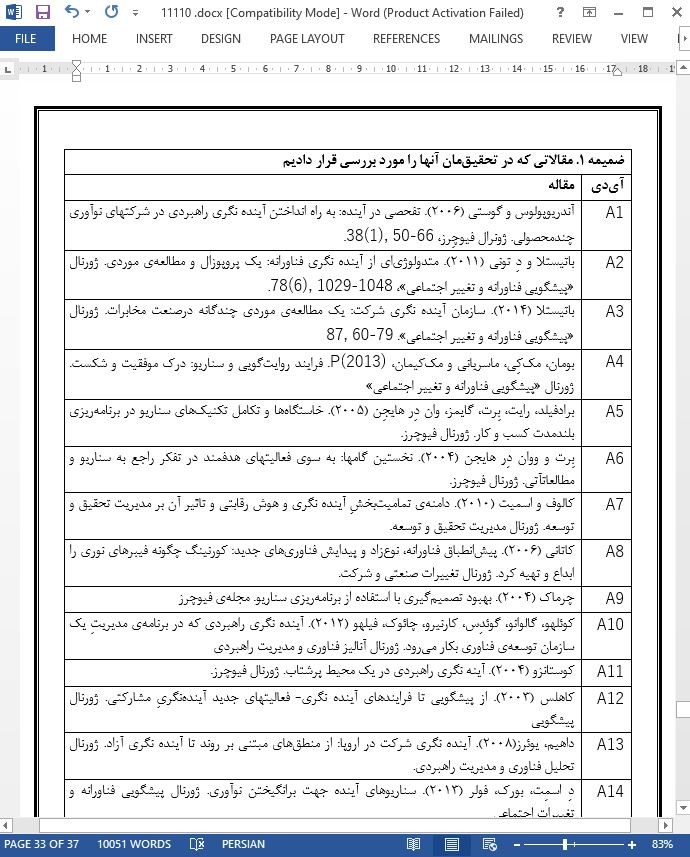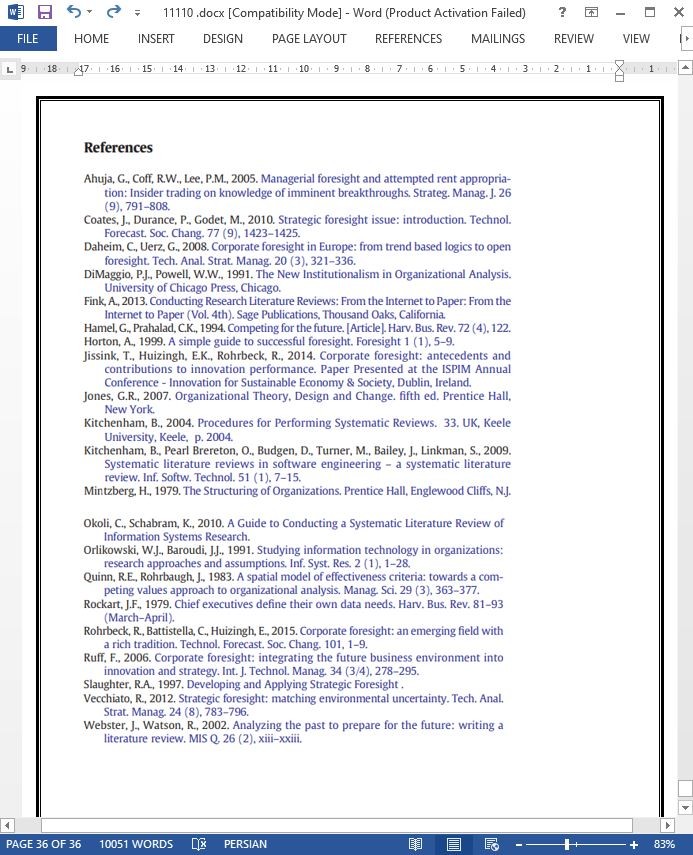
ماهیت تحقیقات آینده نگری راهبردی
چکیده
آیندهنگری راهبردی یک حوزهی علمی است که طی دههی گذشته توسعهی پرشتابی داشته است، به این دلیل که تعداد مقالات و متون پژوهشی که طی این دهه در این زمینه منتشر شده است، هر سال افزایش داشته است. مشخصات تحقیقات صورت گرفته در این حوزه چیست؟ ما جهت پاسخ به این پرسش، اقدام به انجام یک بررسی نظام مند نمودیم تا در دو پایگاه دادگان، برای مقالات علمیِ مرتبط با «آیندهنگریِ راهبردی» در زمینه سازمان، جستجو نماییم: Business Source Complete و ScienceDirect. حاصل جستجوهایمان 59 متن پژوهشی بود که از ژانویه 2000 تا اکتبر 2014 انتشار یافته بودند. این مقالات بصورت نظام مند سازماندهی و تحلیل شدند. بررسی ما وضعیت این حوزهی پژوهشی نوظهور راروشن میسازد. هرچند که ما شاهد رشد علاقهی آکادمیک به آیندهنگری راهبردی هستیم، استدلالمان این است که این حوزهی علمی بخوبی سازماندهی نشده است و فاقد پیشرفت نظری است. ما سوژههای تحقیقی را که این 59 مقاله به آنها پرداخته اند، تحلیل کردهایم. سه مقوله از نظر تعداد مقالات، غالب هستند: روشهای بکاررفته، یا شیوههای سازماندهی و تجارب حاصله. تحقیقات محدودی در زمینهی انگیزش و کاربری، سهم ارزش و نوآوری وجود دارد. در این زمینه، پژوهشهای اکتشافی غالب و چیرهاند و انواعی از دیدگاههای نظری نیز بکار رفتهاند. تلاشهایی جهت ایجاد بنیانهای مفهومی مشاهده میشود، اما بطور کلی هیچ دیدگاهی پیدا نکردیم که شایستهی وفاداری باشد که بر اساس آن شالودهی نظری منسجمی از آیندهنگری راهبردی شکل گیرد. آیندهنگری راهبردی واجد پتانسیل عظیمی است که میتواند سهم و نقش بیشتری در موفقیت یک شرکت داشته باشد، اما در صورتیکه تحقیقات از سلطهی تحقیقات اکتشافی کمی خارج شود و به سمت تحقیقات تبیینی نیز حرکت کند.
1. مقدمه
این مقاله به بررسی تحقیقات موجود در زمینهی کاربرد آیندهنگری راهبردی در شرکتها میپردازد. آیندهنگری راهبردی عبارت است از درک آینده و بکارگیری نگرشهای آیندهگرا برای فعالیتهای راهبردی یک سازمان و تصمیمگیریهای آن. راربِک (2015) پیشینهای تاریخی را از حوزهی تحقیقات آیندهنگری ارائه میدهد: از زمان پیدایش آن در دهه 1950 از طریق تهیهی سناریو در بازهی زمانی دهههای 1960-1970، تا یکپارچگی سازمانی از سال 2000 تا به امروز. اصطلاحات مختلفی بکار رفتهاند تا تفکر آیندهنگر را به تصمیمگیری راهبردی در شرکتها مرتبط سازند. هامل و پراهالاد (1994)، آیندهنگری صنعت را اینگونه تعریف میکند: بینشهای عمیق در خصوص روندهایی که میتوان جهت خلق فضای رقابتی جدید بکار برد. اسلاتر (1997) از اصطلاح آیندهنگری راهبردی جهت نمایش همجوشیِ روشهای آینده با روشهای مدیریت راهبردی استفاده کرده است. آهوجا و همکارانش (2005) از آیندهنگری بعنوان توانمندی شخصی در پیشگویی استفاده کردهاند. آنها آیندهنگری مدیریتی را اینگونه تعریف میکنند: توانایی پیشبینی اینکه اقدامات مدیران تا چه اندازه میتواند مزیت رقابتی تولید کند. راربِک و همکارانش (2015) از اصطلاح آیندهنگری شرکت، بعنوان شیوهای استفاده میکنند که به سازمان امکان فراهم کردن شالودهی مزیت رقابتیِ آتی را از طریق ارزشآفرینی، میدهد.
5. نتیجه
آینده نگری راهبردی یک رویکرد نظام مند جهت یادگیری و درک آیندهی احتمالی و ایجاد دیدگاههای مشترک است و هدفش هدایت و توانمندسازی تصمیمات فعلی میباشد. آینده نگری راهبردی عبارت است از «.... درک فرایندهایی که در ترسیم اقدامات آتی شرکت به تصمیمگیران یاری میرسانند» (وچیاتو، 2012).
در این مروری که ما بر متون پژوهشی داشتیم، بطور نظام مند مقالات تحقیقی را در خصوص آینده نگری راهبردی در زمینه سازمانی مورد بررسی قرار دادیم. ما مقالات را بر حسب پرسشهای تحقیقاتی خاص آنالیز کردیم. این بررسی به چند شیوه در غنای تحقیقات موثر است. نخست اینکه مروری نظام مند از تحقیقات فعلی در این حوزه را ارائه میدهد. ما 59 مقاله مهم را شناسایی کردیم. این مقالات بصورت نظام مند دستهبندی شدهاند که وضعیت فعلی این حوزهی تحقیقاتی نوظهور را ارائه میدهد و کار محققان را برای مطالعات مرتبط آسان میسازد. دوم اینکه از طریق یک آنالیز جامع، ما حوزهها و رویکردهای بالقوه را برای مطالعات آتی مطرح ساختیم. این بررسی نتیجه میگیرد که روش، سازماندهی و تجارب، غالبترین موضوعات در تحقیق فعلی میباشند. این بررسی نشان داده است که تعداد محدودی تحقیق در زمینهی انگیزش و کاربرد، سهم ارزش و نوآوری وجود دارد. ما محققان را به پیوستن به این حوزهی تحقیقاتی دعوت میکنیم.
Abstract
Strategic foresight is a scientific field in rapid development judged from the increase in number of yearly publications the last decade. What characterizes the research in this field? To answer this question we undertook a systematic literature review searching two library databases, Business Source Complete and ScienceDirect, for scientific articles related to the topic ´strategic foresight´ in the context of the organization. The search revealed 59 publications published between January 2000 and October 2014. The articles were systematically organized and analyzed. This review provides the status of this emergent research field. Although we witness a growth of academic interest in strategic foresight, we argue that this scientific field is weakly organized and there is a lack of theoretical progress. We have analyzed the research subjects addressed in the 59 articles, and from this a taxonomy of eight categories. Three categories dominate in terms of frequency of articles: methods applied, organizing practices, and experiences gained. There is only limited research on motivation and use, value contribution, and innovation. Explorative research dominates, and a variety of theoretical perspectives has been used. Some attempts to build conceptual foundations can be observed, but in general, we found no single perspective that deserves loyalty on which a coherent theoretical foundation of strategic foresight is built. Strategic foresight has a great potential of contributing more to the success of a firm if the research moves from today's dominating explorative research to also include more explanatory research.
1. Introduction
This article reviews existing research on the use of strategic foresight in firms. Strategic foresight involves understanding the future and applying future oriented insights to an organization's strategic activities and decision making. Rohrbeck et al. (2015) gives an historical background of the foresight research field, from its birth in the 1950s through scenario building in the 1960s–1970s, to organizational integration from 2000 to present. Different terms have been used to relate foresight thinking to strategic decision making in corporations. Hamel and Prahalad (1994) define industry foresight to be deep insights into trends that can be used to create new competitive space. Slaughter (1997) uses the term strategic foresight to represent a fusion of futures methods with those of strategic management. Ahuja et al. (2005) use foresight as a personal power of foreseeing. They define managerial foresight as the ability to predict how managers' actions can create competitive advantage. Rohrbeck et al. (2015) use the term corporate foresight as a practice that permits an organization to lay the foundation for a future competitive advantage through value creation.
5. Conclusion
Strategic foresight is a systematic approach to learning and understanding possible futures and building shared visions and is aimed at guiding and enabling present-day decisions. It is “… understood as the processes that assist decision makers in charting the firm's future course of action” (Vecchiato, 2012).
In this literature review, we systematically reviewed research articles on strategic foresight in an organizational context. We analyzed the contributions with respect to specific research questions. This review contributes to research in several ways. First, it provides a systematic overview of existing research in this area. We identified 59 significant contributions. The contributions were systematically categorized, which provides the current status of this emergent research field and will ease researchers' search for relevant studies. Second, through a thorough analysis, we proposed potential areas and approaches for future studies. The review concludes that method, organizing, and experiences are the most dominant topics in current research. The review showed that there is only limited research on motivation and use, value contribution, and innovation. We encourage researchers to join this current research area.
چکیده
1. مقدمه
2. روش
2.1 بررسی موضوعات یا تاپیکها
2.2 فرایند یا پروسهی تحقیق
2.3 معیارهای لحاظ کردن یا لحاظ نکردن (دربَرگرفتن و دربَرنگرفتن)
2.4 گردآوری دیتا
3. نتایج
3.1 چه تحقیقاتی در خصوص آیندهنگری راهبردی انجام گرفتهاند؟
3.2 به چه سوژههای پژوهشی پرداخته شده است؟
3.3 چه چارچوبهای نظری و نظریههای مرجعی، در بررسی تاپیک/موضوع بکار رفتهاند؟
3.4 چه روشهای تحقیقی به کار گرفته شدهاند؟
4. بحث و تبادل نظر
4.1 اتخاذ/پذیرش
4.2 رویکرد
4.3 برونداد
5. نتیجه
Abstract
1. Introduction
2. Method
2.1. Review topics
2.2. The search process
2.3. Inclusion and exclusion criteria
2.4. Data collection
3. Results
3.1. What research has been conducted on strategic foresight?
3.2. What research subjects have been addressed?
3.3. What theoretical frameworks and reference theories have been applied to study the topic?
3.4. What research methods have been used?
4. Discussion
4.1. Adoption
4.2. Approach
4.3. Outcome
5. Conclusion
- اصل مقاله انگلیسی با فرمت ورد (word) با قابلیت ویرایش
- ترجمه فارسی مقاله با فرمت ورد (word) با قابلیت ویرایش، بدون آرم سایت ای ترجمه
- ترجمه فارسی مقاله با فرمت pdf، بدون آرم سایت ای ترجمه



